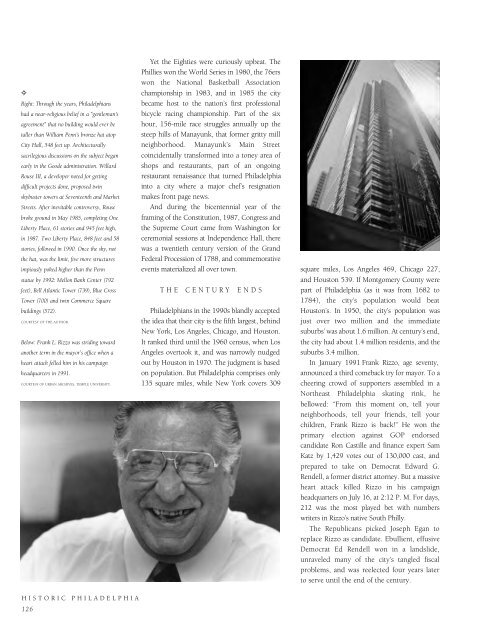Historic Philadelphia
An illustrated history of the city of Philadelphia, paired with the histories of companies, families and organizations that make the region great.
An illustrated history of the city of Philadelphia, paired with the histories of companies, families and organizations that make the region great.
Create successful ePaper yourself
Turn your PDF publications into a flip-book with our unique Google optimized e-Paper software.
✧<br />
Right: Through the years, <strong>Philadelphia</strong>ns<br />
had a near-religious belief in a “gentleman's<br />
agreement” that no building would ever be<br />
taller than William Penn’s bronze hat atop<br />
City Hall, 548 feet up. Architecturally<br />
sacrilegious discussions on the subject began<br />
early in the Goode administration. Willard<br />
Rouse III, a developer noted for getting<br />
difficult projects done, proposed twin<br />
skybuster towers at Seventeenth and Market<br />
Streets. After inevitable controversy, Rouse<br />
broke ground in May 1985, completing One<br />
Liberty Place, 61 stories and 945 feet high,<br />
in 1987. Two Liberty Place, 848 feet and 58<br />
stories, followed in 1990. Once the sky, not<br />
the hat, was the limit, five more structures<br />
impiously poked higher than the Penn<br />
statue by 1992: Mellon Bank Center (792<br />
feet), Bell Atlantic Tower (739), Blue Cross<br />
Tower (700) and twin Commerce Square<br />
buildings (572).<br />
COURTESY OF THE AUTHOR.<br />
Below: Frank L. Rizzo was striding toward<br />
another term in the mayor’s office when a<br />
heart attack felled him in his campaign<br />
headquarters in 1991.<br />
COURTESY OF URBAN ARCHIVES, TEMPLE UNIVERSITY.<br />
HISTORIC PHILADELPHIA<br />
126<br />
Yet the Eighties were curiously upbeat. The<br />
Phillies won the World Series in 1980, the 76ers<br />
won the National Basketball Association<br />
championship in 1983, and in 1985 the city<br />
became host to the nation’s first professional<br />
bicycle racing championship. Part of the six<br />
hour, 156-mile race struggles annually up the<br />
steep hills of Manayunk, that former gritty mill<br />
neighborhood. Manayunk’s Main Street<br />
coincidentally transformed into a toney area of<br />
shops and restaurants, part of an ongoing<br />
restaurant renaissance that turned <strong>Philadelphia</strong><br />
into a city where a major chef’s resignation<br />
makes front page news.<br />
And during the bicentennial year of the<br />
framing of the Constitution, 1987, Congress and<br />
the Supreme Court came from Washington for<br />
ceremonial sessions at Independence Hall, there<br />
was a twentieth century version of the Grand<br />
Federal Procession of 1788, and commemorative<br />
events materialized all over town.<br />
THE CENTURY ENDS<br />
<strong>Philadelphia</strong>ns in the 1990s blandly accepted<br />
the idea that their city is the fifth largest, behind<br />
New York, Los Angeles, Chicago, and Houston.<br />
It ranked third until the 1960 census, when Los<br />
Angeles overtook it, and was narrowly nudged<br />
out by Houston in 1970. The judgment is based<br />
on population. But <strong>Philadelphia</strong> comprises only<br />
135 square miles, while New York covers 309<br />
square miles, Los Angeles 469, Chicago 227,<br />
and Houston 539. If Montgomery County were<br />
part of <strong>Philadelphia</strong> (as it was from 1682 to<br />
1784), the city’s population would beat<br />
Houston’s. In 1950, the city’s population was<br />
just over two million and the immediate<br />
suburbs’ was about 1.6 million. At century’s end,<br />
the city had about 1.4 million residents, and the<br />
suburbs 3.4 million.<br />
In January 1991 Frank Rizzo, age seventy,<br />
announced a third comeback try for mayor. To a<br />
cheering crowd of supporters assembled in a<br />
Northeast <strong>Philadelphia</strong> skating rink, he<br />
bellowed: “From this moment on, tell your<br />
neighborhoods, tell your friends, tell your<br />
children, Frank Rizzo is back!” He won the<br />
primary election against GOP endorsed<br />
candidate Ron Castille and finance expert Sam<br />
Katz by 1,429 votes out of 130,000 cast, and<br />
prepared to take on Democrat Edward G.<br />
Rendell, a former district attorney. But a massive<br />
heart attack killed Rizzo in his campaign<br />
headquarters on July 16, at 2:12 P. M. For days,<br />
212 was the most played bet with numbers<br />
writers in Rizzo’s native South Philly.<br />
The Republicans picked Joseph Egan to<br />
replace Rizzo as candidate. Ebullient, effusive<br />
Democrat Ed Rendell won in a landslide,<br />
unraveled many of the city’s tangled fiscal<br />
problems, and was reelected four years later<br />
to serve until the end of the century.
















